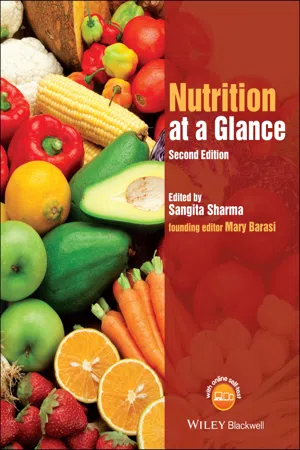
Nutrition at a Glance
Tony Sheehy, Fariba Kolahdooz, Tony Sheehy, Fariba Kolahdooz
- English
- ePUB (disponibile sull'app)
- Disponibile su iOS e Android
Nutrition at a Glance
Tony Sheehy, Fariba Kolahdooz, Tony Sheehy, Fariba Kolahdooz
Informazioni sul libro
Nutrition at a Glance introduces key nutrition facts, such as the role of key nutrients in maintaining health, and addresses the concepts of nutrient metabolism, nutritional intake and what makes an adequate diet. It covers food safety, allergy and intolerance, GM foods, diet-related diseases and nutrigenomics. Nutrition at a Glance: • Is superbly illustrated, with full colour illustrations throughout
• Includes nutrition 'hot topics' such as gene-nutrient interactions and dietary supplements
• Has strong international appeal, with different dietary requirements provided for many countries
• Is a reference text suitable for post-docs and junior scientists, including those working in public health and dietetics
• Includes a companion website at www.ataglanceseries.com/nutrition featuring interactive multiple choice questions, abbreviations, a glossary, references and further reading, and Appendix B 1: Global dietary guidelines and Dietary Reference Intakes
Domande frequenti
Informazioni
Part I
Nutrients including carbohydrates, fat, proteins, vitamins, minerals, and alcohol
1
Introduction to the nutrients
Aims
- To show how nutrients are classified and discuss their main roles
- To describe how nutrients may interact to fulfil similar roles
Classification of nutrients
- Macronutrients are required in relatively large amounts, usually expressed in terms of grams per day.
- Micronutrients are required in small amounts, usually expressed in terms of milligrams or micrograms per day.
Macronutrients
- Carbohydrates and fats are the major providers of energy, although proteins can also be used to provide energy.
- They all have a structural role in the body, the most important in this respect being proteins.
- All contain carbon, hydrogen and oxygen. In addition, all proteins contain nitrogen, while some amino acids (cysteine and methionine) that are found in proteins contain sulphur.